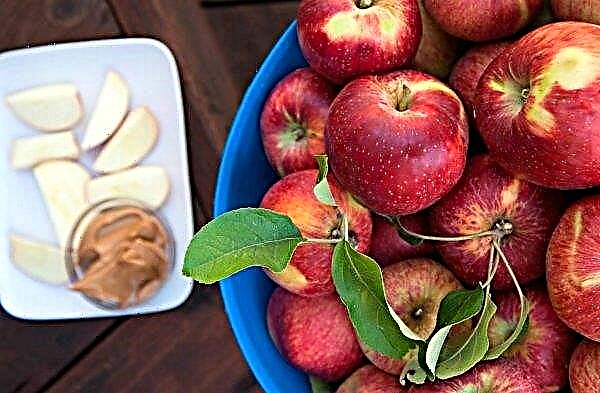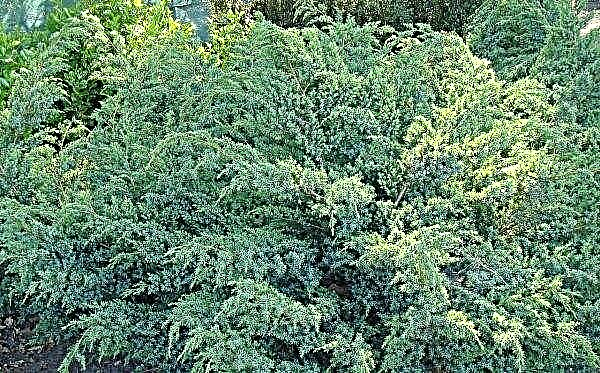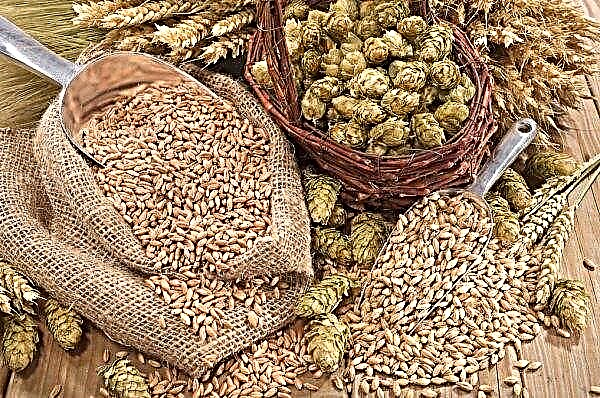In the system of measures aimed at solving the aesthetic problems of the body, from ancient times, various essential and vegetable oils were widely used, and sometimes very unexpected ones. It is in this category of products that products derived from the embryos of cereals, in particular wheat, belong. About how squeezing from a wheat germ can affect our appearance, what is valuable and useful in this oil and how to use it to care for skin and hair, hereinafter in all details.
What is wheat germ oil
Wheat grain, as you know, consists of a dense shell, a tiny germ located in the lower part of the grain, and endosperm - a powdery substance from which the future sprout will be able to obtain the nutrients necessary for its further development.

Modern science has reliably proved what our ancestors had long suspected: it was the germ of the grain, i.e. that part of it, which has the ability to germinate and, thus, actually give rise to a new life, is the most valuable and contains much more nutrients than the shell that occupies the main part of the grain and even, oddly enough, the endosperm.
Important! Comparison of the enzymatic activity of different parts of the grains shows that in the embryo these indicators are higher compared to the endosperm: 10 times for the protein group, 4 times for the lipid group, 8 times for the phytase group and 30 times for the oxidative group.
It is not surprising that oils and extracts obtained from wheat germ are considered today as natural immunomodulators, providing a significant increase in the body's resistance to any negative environmental factors.
Obtaining oil from the considered part of plant materials is carried out on an industrial scale in several different ways. At the same time, despite the fact that the main goal of the production process should be to ensure maximum preservation of the vitamin, biochemical and enzyme composition of the initial product, it is far from always possible to achieve such a result. In the spinning process, it is often necessary to use both the chemical and hydrothermal effects on the grain, which significantly reduces, and sometimes completely negates, the whole nutritional and therapeutic value of the finished product.

To a large extent, the situation can be improved by a relatively new technique for producing medicinal oil by cold pressing. Unlike classical extraction, it involves exposure to the grain only by mechanical means, without heating and chemical treatment. As for extraction, among all its types used, the most optimal from the point of view of preserving the initial biological composition of the raw material is treatment with saturated hydrocarbon (hexane) at room temperature.
Important! A chemical analysis of wheat germ oil obtained by high-quality extraction and cold pressing methods shows that the first version of the product contains a high content of hydrocarbons, free fatty acids and glycerides, while the second is rich in phospholipids, glycolipids, sterols and wax.
Raw oil looks like a very thick and viscous liquid. It is it that is most often used in cosmetology - in its pure form or in combination with other plant squeezes. This mixture is added to masks, creams, shampoos, balms and other beauty recipes. In the processed form, the product intended for external use receives a more liquid form and is enriched with various flavors and cosmetic fragrances.

Chemical composition
Wheat germ oil is a unique natural product that contains in concentrated form a huge amount of vitamins, as well as other nutritional and biologically active components.
Of the vitamins found in the product:
- carotenoids (vitamin A group);
- tocopherol (vitamin E);
- ergosterol (vitamin D);
- folic acid (vitamin B9);
- riboflavin (vitamin B2);
- thiamine (vitamin B1);
- niacin (vitamin PP);
- pantothenic acid (vitamin B5).
The specific amount of each of these vitamins directly depends on the quality of the feedstock. For example, in hard wheat varieties, these beneficial components are always greater. However, in the list of vegetable oils, it is squeezed from wheat germ that has the highest vitamin E content. Moreover, more importantly, tocopherol in this product is presented in its most active forms. So, almost ¾ of vitamin E of the total 170–1200 microgram-percent is presented in the form of alpha tocopherols.
The share of badly assimilable tocopherols of beta, gamma and sigma groups is 7.75% of the total vitamin content, and 6.9% is accounted for by tocopherol acetate - the most active antioxidant that prevents lipid peroxidation, often intensified due to inflammatory processes in the body.

Further, the product is very rich in unsaturated fatty acids of the linoleic group. They are also sometimes called Vitamin F. In particular, fatty acids such as are present in wheat germ oil:
- linoleic;
- linolenic;
- myristic;
- stearic;
- palmitic;
- palmitoleic;
- oleic;
- eruca.
The product is also rich in amino acids, both interchangeable and irreplaceable.
| The first group of the amino acid series found in the composition of wheat germ oil includes: | As for the essential amino acids, they are represented by such substances: |
|
|
It is noteworthy that it is the above “eight” of essential amino acids that are considered the most important and valuable for living organisms, including the human.
Important! The main value of linoleic acid for the body is that it, being converted to arachidonic acid by means of tocopherol and B vitamins, provides fat metabolism.
Further, the product is rich in minerals such as manganese, vanadium, silicon and boron. Also, it contains phosphorus, copper, selenium, zirconium and cobalt, however, the dose of these trace elements is negligible.
Among the proteins, wheat germ oil contains albumin and geobulin, as well as other substances characterized by good digestibility and high solubility in water or salt. Interestingly, in their nutritional value, composition and chemical nature, these plant proteins are very similar to animals, in particular, those found in chicken egg, casein, milk powder and beef.
Finally, the carbohydrate composition of the oil is mainly represented by sucrose, as well as raffinose, maltose and mannose. Also in the product was found an ultrahigh content of pentosans, which, in turn, are the building material for coenzymes, ribonucleic acids and disoxyribonucleic acid (DNA).

Healing properties for skin and hair
The healing properties of wheat germ oil, including when used in cosmetology, are due to the unique combination of three biologically active complexes in the product:
- vitamin B and D;
- essential and unsaturated fatty acids in a ratio of 3: 1, which is considered optimal for lipid metabolism;
- the strongest antioxidants in the form of tocopherols and carotenoids.
Thereby natural remedy softens, moisturizes, tones and nourishes the skin, prevents its premature aging, improves its color, relieves irritation, has an exfoliating effect, stimulates blood microcirculation and fat metabolism in the epidermal cells.
Did you know? The most expensive vegetable oil in the world is produced from the fruits of arganum prickly, also known as iron tree. The plant is found only in a small region of North Africa and gives no more than 6-8 kg of crop during the season.
How to choose wheat germ oil
Wheat germ oil is not a very common product, therefore, it is quite difficult to distinguish a quality product from a fake by external signs. If it is possible at the time of purchase to familiarize yourself with the sampler of the product, experts recommend paying attention to three characteristic features inherent in the original:
- texture: viscous liquid;
- Colour: all shades of brown, from light golden to deep amber;
- the scent: pronounced, reminiscent of mowed grass.
 Oil should be purchased only from trusted sellers, it is better that it is a pharmacy or a store of high-quality natural cosmetics. Permissible packaging - tightly sealed container made of dark glass.
Oil should be purchased only from trusted sellers, it is better that it is a pharmacy or a store of high-quality natural cosmetics. Permissible packaging - tightly sealed container made of dark glass.
Before buying, you should also carefully study the composition of the product and other information provided by the manufacturer about it. In addition to the fact that in the list of components there should not be any extraneous additives, except, in fact, the plant base, as already mentioned, a product made by cold pressing rather than extraction is more useful and valuable.
Terms of use
In cosmetology, wheat germ oil is used in different ways, including:
- in pure form;
- in combination with various combinations of essential oils;
- as one of the ingredients of masks, creams, balms and other care and therapeutic agents.
Did you know? The Chinese empresses used regular silk tissue massage to increase facial skin tone. Today it has been established that the effect of this procedure was achieved due to the microdischarges of electricity generated during friction, which actually stimulate cell regeneration.
Compositions prepared using the product in question can be applied by direct application to the skin (face, eyelids, lips, hands, feet, other problem areas), as applications, compresses and wraps, for different types of massage, in the form of baths.
The best recipes for masks at home
Wheat germ oil is useful for anyone who cares about their appearance in their medicine cabinet.
- This component can become an indispensable additive in the manufacture of many home masks of very different target areas, including for:
- care for problem skin of all types and localization;
- improving hair structure;
- fight against disorders of microcirculation in adipose tissue (cellulite) and stretch marks.
Below are the 8 best beauty recipes that will require an ingredient like wheat germ oil. In each of these recipes, the therapeutic effect is achieved due to a certain combination of the considered component, taken as a base (base) with other types of vegetable and essential oils.

For aging skin
Rejuvenate the skin, make it more toned, fresh and velvety a combination of the main component from wheat germ (1 tablespoon) with a mixture of three essential oils taken in one drop - sandalwood, pink and peppermint (can be replaced with orange) will help.
The resulting mask is applied to the cleansed skin with light massaging movements, left for 15-20 minutes, then carefully remove the residues with a damp cloth or a special sponge. In addition to general rejuvenation, this mixture allows you to noticeably smooth even the deepest wrinkles.
Important! When preparing masks, you must first mix the essential components with each other and then gradually add the base to them. In this case, it is best to use a wooden stick, and the dishes themselves should be glass or ceramic.
For wrinkles around the eyes
If the "crow's feet", dark circles and edema cover the area of the skin around the eyes, a combination of the same amount of base with another combination of essential oils will help improve the condition. Two possible supplements are possible here:
- sandalwood, limet and orange blossom - each component 1 drop;
- sandalwood and rose - 2 drops each.
Having carefully mixed all the components, two cotton balls should be dipped into the resulting substance, put on closed eyes (before using the mask, the face should be washed, removing any remaining cosmetics, dirt and grease), and then lie quietly for 15-20 minutes. The effect is enhanced by aromatherapy and calm pleasant music. After removing the compresses, it remains only to gently blot the area around the eyes with a soft cloth moistened with warm water and apply a light nourishing cream to the skin.

For dry skin
Wheat germ oil It has a moisturizing effect that allows you to use it to care for overdried and flaky skin (for example, after tanning or as a result of weathering), as well as simply when it is dry. In this case, the product is suitable as a mask in its pure form, without any additives, but it is possible to enrich and aromatize a cosmetic product by mixing it with essential oils of roses, lemon balm, mint or lime fruit (1-2 drops per 1 tablespoon of base) .
The drug will help and improve hand skin condition, especially if, as a result of contact with detergents or other aggressive substances, the hands begin to peel off, become flabby, lose their softness, become covered with microcracks. To improve the condition of the skin, an oil base without additional components is recommended to be applied to the hands and rubbed thoroughly with massage movements after each contact with water. To make the mixture more aromatic, you can add a couple of drops of essential oil of bergamot or lavender to it.
 If there are problems, it is recommended to apply the treatment composition up to three times a day, for standard care - as a normal mask, not more than 1-2 times a week, in combination with a gentle massage.
If there are problems, it is recommended to apply the treatment composition up to three times a day, for standard care - as a normal mask, not more than 1-2 times a week, in combination with a gentle massage.
For oily
Oddly enough, a unique composition of wheat germ extract may be useful even to owners of oily skin. Despite the high content of its own fatty acids, due to the complex action of minerals, vitamins and antioxidants, this remedy able to remove unnatural shine of the skin, make it matte. True, for this it is important to choose the right combination of other ingredients.
A classic version of a mask for oily skin is a mixture of two vegetable oils - grape seed and wheat germ. The optimal ratio is 3: 1. The product is applied to cleansed face skin, after 30 minutes, its residues are washed off with warm water. Besides, the mentioned bicomponent composition can be added to any mask for oily skin, which will greatly enhance its effect.
For acne
Lubricating the skin with wheat germ oil also has a beneficial effect in the presence of problems such as acne, teenage acne and other such dermatological defects. Additional additives in this case can not be used, but if desired, it is permissible to dilute the base with two drops of any of these essential oils:
- cedar;
- juniper;
- cloves;
- lavender;
- bergamot;
- lemon;
- grapefruit;
- white tree (kayaput).
The prepared mask should be applied to a napkin or cotton sponge and applied to problem areas for 15–20 minutes, after which wash with plenty of warm water. The frequency of the procedure is daily or, with severe problems, 2 times a day.
 The same tool allows you to get rid of age spots, make freckles less noticeable, provide a noticeable whitening effect.
The same tool allows you to get rid of age spots, make freckles less noticeable, provide a noticeable whitening effect.
From stretch marks
Various natural oils, both massage and essential, have long and successfully been used to combat stretch marks.. Such products, due to their high content of fatty acids, vitamins and other active substances, perfectly nourish the skin, while soothing, moisturizing and toning it.
The methods for treating stretch marks with vegetable fats can be different - regular lubrication, applying in the form of a compress, wrap or mask, as well as massage and baths. Wheat germ oil is one of the five most popular basic treatment options, along with the extraction of jojoba, sugar kelp, avocado and macadamia.
Important! Sea buckthorn oil can not be added to the treatment for stretch marks, since it dries the skin, that is, it gives the opposite effect to the desired.
When applying a fatty base to problem skin, several basic rules must be observed:
- body surface should be clean and slightly moist;
- in no case should you massage and rub the product;
- exposure time - from 5 to 7 minutes;
- after the procedure - careful removal of residual fat with a dry cloth.

Adding essential oils to the base mix greatly enhances the effect., since such overactive components stimulate blood circulation, increase muscle tone, relieve swelling, that is, ultimately make the skin taut, elastic and elastic. Products made from lavender, rose, orange, rosemary, frankincense, geranium, mint, cloves and neroli are best suited for these purposes.
- Various combinations of such components give the finished mixture one or another additional property, for example:
- invigorating (suitable for morning use);
- soothing (better to use before bedtime);
- preventive;
- enhanced action.
From cellulite
One of the proven means of combating cellulite is a harsh massage. The effectiveness of the procedure can be significantly improved by using a suitable oil. Wheat germ extraction is one such option, it can also be mixed with other vegetable oils, in particular apricot or peach kernels, as well as almonds. The proportions are used different, but for the wheat component, as a rule, from 25 to 50% is allocated, no less.
Did you know? Losing weight does not just not help get rid of cellulite, but even visually increases its effect.
To obtain a more aggressive and burning product, it is recommended to add essential oils to the base prepared in this way (at the rate of 1 drop of each component per 1 tablespoon of the base mixture):
- juniper;
- Lemon
- cedar;
- fennel;
- geraniums.

For hair
Various vegetable oils, including squeezed from wheat germ help to stop or slow down hair loss. You can use it as a base in its pure form or in combination with burdock or jojoba oil. Of the essential extracts that are appropriate when preparing a hair mask (as always, 1-2 drops per 1 tablespoon of base), it is worth mentioning the essential oils:
- thyme
- an orange;
- cedar;
- eucalyptus;
- juniper;
- fir;
- pine trees;
- ginger
- Limetta.
Like all similar products, an oil mask is applied to the slightly moistened scalp under the hair, rubbed thoroughly into it, and then the remnants of the product are distributed over the entire length of the hair. Next, you need to create a bath effect for 15–20 minutes, for which it’s enough to wrap your head with plastic wrap and tie a turban from a towel on top. At the end of the mask, the hair should be washed immediately using ordinary shampoo.
Did you know? The longest hair in the world belongs to Chinese Xie Quiping. For 13 years of absence of a haircut, a woman managed to grow braids with a length of 5.627 m.
In addition, there are masks specifically designed to care for a particular type of hair.
So, if the hair is too oily, this mixture is suitable for them:
- kefir - 3 tbsp .;
- wheat germ oil - 1 tbsp;
- freshly squeezed lemon juice - 5 tbsp.
The exposure time is 20 minutes. In the case of dry hair, it is better to replace kefir with yogurt, and lemon juice with a mashed banana. To combat the cut ends, add 1 tablespoon to any of the recipes described. honey.

Possible harm and contraindications for external use
The main danger that wheat could potentially be is related to its high gluten content.. The body of many people is not able to absorb this protein, which is expressed in serious damage to the digestive system. This disease, which has a complex nature, which includes autoimmune, allergic, and hereditary factors, is called celiac disease, or celiac enteropathy.
However, celiac disease is a disease of the internal organs. Gluten is not capable of harming skin. even to people who are forced to completely eliminate gluten-free foods from their diet.
Did you know? Modern studies have shown that individual gluten intolerance at the genetic level is present in one out of a hundred people on the planet. For comparison: from 30 to 40% of the world's population suffers from allergies in its various forms today.
No other serious contraindications or cases of harm caused to health as a result of external use of wheat germ oil have been identified by clinical trials. However traditionally, it is customary to include in the list of contraindications such a collective concept as individual intolerance, since theoretically any component that is part of a complex biologically active agent can cause a negative reaction, including an external one (redness of the skin, itching, burning, etc.).
For security, Before using a cosmetic product with a new ingredient, apply a small amount of the product to the skin and wait a few minutes. In the presence of any unpleasant sensations or visible changes in the skin, it makes sense to refuse to use the product.

A serious danger when using the masks described above may come not from the base, but from additional ingredients - various kinds of essential oils. Even with a slight overdose, they can cause serious chemical burns, an allergic reaction, and other side effects.
In order to avoid such problems in the composition of cosmetic products, essential oils should be no more than 3-5%. This ratio in practice means that 1 tbsp. basics, you can add no more than 3-5 drops of useful, but rather aggressive additives.
How to store oil
The same rules apply for storing wheat germ oil as for any other vegetable oils. So, the container for the product must be glass and opaque. Tight corking is mandatory. The contents of the vial should be as small as possible in contact with air, for this the container should be kept filled almost to the brim.
The optimum temperature regime is in the range + 5 ... + 20 ºС. In addition, it is advisable to protect all vegetable oils from light and drafts. Subject to these conditions, the beneficial cosmetic properties of the product of extraction of wheat germ remains for 12 months from the moment of uncorking the bottle, unless otherwise specified by the manufacturer on the package.

After the expiration of the storage period or a change in the physical characteristics of the liquid (turbidity, rancid odor, etc.), the oil cannot be used not only for food, but also externally. An exception to this rule is the presence of sediment: in this capacity, wax usually collects at the bottom of the bottle. Such stratification does not affect the suitability of the finished product, but the container must be thoroughly shaken before use.
As for the prepared masks, they can be stored in a dark glass dish from 4 weeks to 3 months, although a good cosmetologist tries to use this kind of product immediately after mixing the components.
Wheat germ oil is a product unique in its chemical composition and beneficial properties, which makes it widely used not only in cooking, but also in medicine and cosmetology. Using this product as an additive to various kinds of masks, balms, creams and shampoos allows you to achieve excellent results in working on your appearance. However, one should not forget that any beauty recipe can bring the expected benefits only if its use is combined with a healthy lifestyle, physical activity, proper nutrition, good sleep and a general positive mood.












